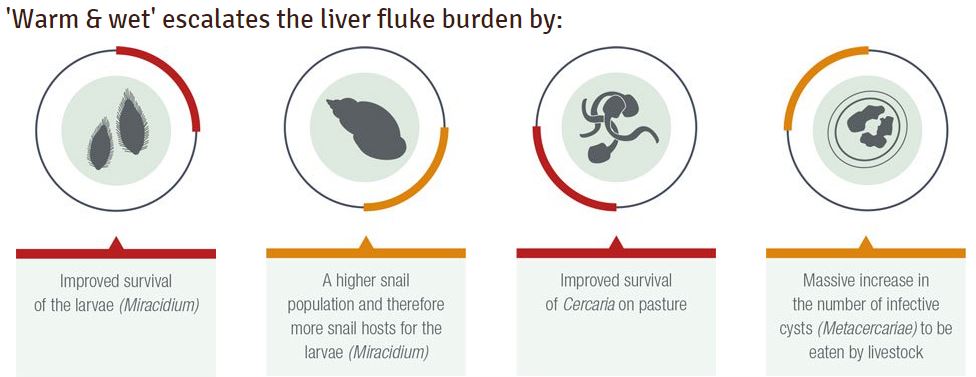With the changing weather patterns across Ireland, liver fluke is extending to previously ‘safe areas’. At the same time, the timings and levels of liver fluke challenge are becoming more variable.
With this in mind, relying on traditional, fixed-time treatments as the sole control strategy is unlikely to give the level of control required for current day production systems.
Failing to control liver fluke may have serious, negative consequences on the performance of your flock. Along with affecting the fertility and milk yield of ewes, liver fluke leads to reduced output and less income¹. Furthermore, the losses – in meat production terms – can be as high as 30% in sheep².
For effective liver fluke control, there are a number of tips that need to be considered.
1. Take the ‘whole farm’ approach
Given the nature of Irish farming, cattle and sheep often graze side by side. Therefore, if sheep are being treated for liver fluke, the cattle present on the farm may also need to be treated.
Failing to do so may see the reintroduction of liver fluke eggs back on to grazing swards to create a possible avenue for reinfection.
2. Reduce snail habitats wherever possible
Key to the spreading of liver fluke is the mud snail; it’s the intermediate host for liver fluke and it thrives in poached areas. Therefore, it’s important to reduce snail habitats wherever possible.
This can be achieved by maintaining existing ditches and drains, repairing leaky water troughs and by minimising poaching around water troughs and gateways.
3. Avoid high-risk grazing
Another key management practice to help reduce the animal’s exposure to liver fluke is to avoid high-risk grazing wherever possible.
Areas with snail habitats are high risk in late autumn and winter. Temporary or electric fencing can be used to restrict access to high-risk areas within fields during this time. If at all possible, you should avoid grazing these areas.
4. Know when the fluke challenge starts on your farm
Having an idea of when the fluke challenge starts on your farm can also help control liver fluke. However, this has become more variable with changing weather patterns.
In addition, there are huge differences between farms – and even fields on some farms – in the same year. By monitoring fluke forecasts and/or by taking samples from first-grazing season lambs can help detect the start of the fluke challenge on your farm.
5. Know the liver fluke stages
Another step to help control the parasite is by knowing what stage of liver fluke are likely to be present in the animals.
For instance, in the early season (autumn / early winter) you will mostly see early-immature and immature fluke.
In the mid-season (late winter / spring), you will see mostly immature and adult fluke as grazing animals pick up fewer fluke from pasture.
In the late season (late spring / summer), mostly adults are seen as all fluke present in the liver have had time to develop.
6. Know your dose
Once you have identified which stages are present, you must seek out the actives which kill the stages of fluke in the liver. For best practice, it’s important to ask your vet or responsibly trained person.
You should aim to use a different active for early, mid and late-season treatments. This is necessary to avoid over reliance on any single active and also to reduce the risk of developing resistance.
7. Quarantine treatments for incoming stock
If your flock is free from liver fluke – especially resistant liver fluke – it’s important that you don’t buy in stock carrying the parasite.
Therefore, it’s important to quarantine any incoming stock and to follow the sustainable control of parasites in sheep (SCOPS) guidelines.
8. Get the basics right
For effective control of liver fluke, it’s important to get the most of your medicines. For this to be achieved, you must know the weight of your animals (weigh them) and calibrate dosing equipment.
Adhering to this will help to make sure that every animal receives the correct dose for body weight.
9. Are your treatments working?
In addition, you should also endeavor to ensure that your treatments are working effectively, as you can’t see if some fluke have been left behind.
Through the use of coproantigen samples – two weeks after treatment – you will know if your treatments have been effective. Click here for more information on sustainable fluke control
References:
- Teagasc Technical Updates on Sheep Production, February 2002, page 76;
- Animal Health Ireland, Parasite Control Leaflet Series. Volume 5, version 2, May 2013.




